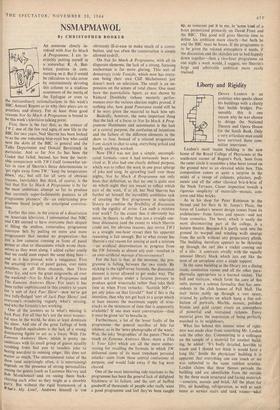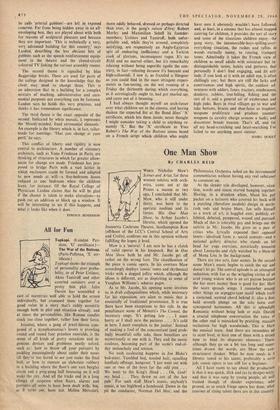Liberty and Rigidity
DENYS LASDUN is an architect who speaks about his buildings with a clarity that builds bridges. Pre- sumably this is one reason why he was chosen to design the National Theatre and Opera House for the South Bank. Only a very articulate man could have survived those com- mittee interviews.
Lasdun's most recent building is the new home of the Royal College of Physicians at the south-east corner of Regent's Park. Seen from the outer circle it resembles a blue beret tossed on the ground next to an elevated white box. This composition comes as quite a surprise in the midst of a sweep of columns, pilasters, pedi- ments and all the other classical bric-11-brac of the Nash Terraces. Closer inspection reveals a rigorous simplicity of materials—mosaic, con- crete and blue bricks. • As in his shop for Peter Robinson in the Strand and his flats in St. James's Place, the force of Lasdun's newest design comes from its architecture—from forms and spaces—and not from cosmetics. The beret, which is easily the most disconcerting part of the college, is a lecture theatre. Because it is partly sunk into the ground its warped and winding walls emerge from the earth without any preparatory plinth. The building therefore appears to be thrusting up through the turf like a rocket coming out of a silo : it contrasts vividly with the equally unusual library block which juts out like the nose of an aeroplane over a single support.
In the same building as the library are a dining room, committee rooms and all the other para- phernalia appropriate to a learned society. The hall and staircase, which form the core of this suite, possess a solemn formality that has ante- cedents in the club houses of Pall Mall. The stair twists nobly up through a vast space, striated by galleries on which hang a fine col- lection of portraits. Marble, mosaic, polished bronze and gold carpet create an atmosphere of powerful and restrained richness. Every material gives the impression of being perfectly matched to its neighbours.
What lies behind this intense sense of right- ness was made clear from something Mr. Lasdun said the other day. Commenting to a colleague on the sample of a material for another build- ing, he added: It's badly detailed, horrible to touch and I should not think it would have a long life.' Inside the physicians' 'building it is apparent that everything one can touch or see was subjected to the same ruthless scrutiny. Lasdun claims that three themes pervade the building and are identifiable from the outside by the three main structural and facing materials —concrete, mosaic and brick. All the plant for lifts, air handling, refrigeration, as well as such items as service stairs and tank rooms—what he calls 'arterial gubbins'—are left in exposed concrete. Far from being hidden away in an all- enveloping box, they are played about with both for reasons of sculptural pleasure and because they are important. 'This is technically a very, very advanced building for this country,' says Lasdun, describing the less obvious bits of gubbins such as the speech reinforcement equip- ment in the theatre and the closed-circuit coloured TV linking the various assembly rooms.
The second theme is signalled by blue Baggeridge bricks. These are used for parts of the college designed in the knowledge that the client may need to change them. This is an admission that in a building for a complex mixture of teaching, administrative and cere- monial purposes not everything can be foreseen. Lasdun says he holds this very precious, and thinks it has tremendous significance.
The third theme is the exact opposite of the second. Indicated by white mosaic, it represents the 'bloody-minded, fixed ceremonial elements.' An example is the library which is, in fact, tailor- made for meetings. 'That you change at your peril,' he says.
This conflict of liberty and rigidity is now central to architecture. A number of visionary architects, such as Yona Friedman in Paris, are thinking of structures in which far greater allow- ances for change are made. Friedman has pro- posed to bridge Paris with a vast lattice in which enclosures could be formed and adapted to new needs at will—a five-bedroom house reduced to one bedroom when the children leave, for instance. Of the Royal College of Physicians Lasdun claims that he will be glad if the chance is taken to make alterations—to push out an addition or block up a window. It will be interesting to see if this happens, and what it looks like when it does.
TERENCE BENDIXSON



































 Previous page
Previous page